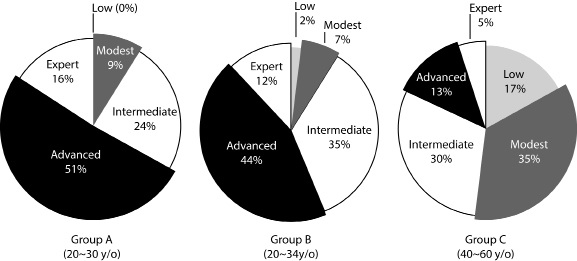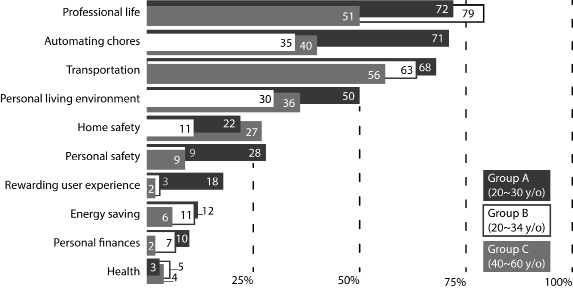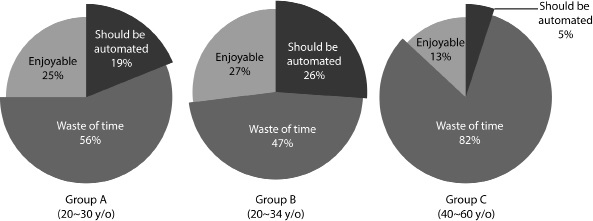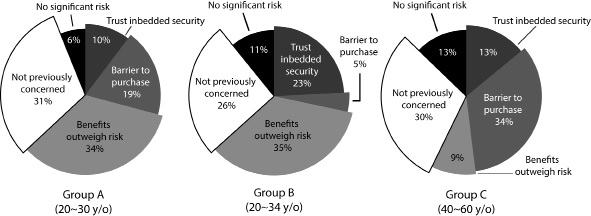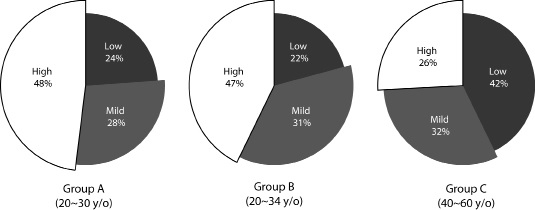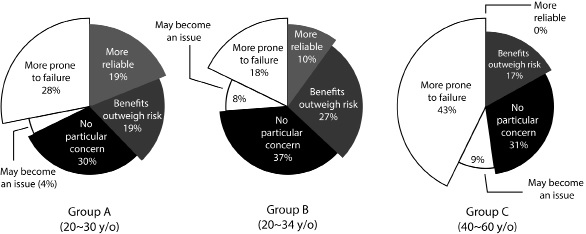
Developing Rewarding, Safe and Sustainable IoT Product Experiences: Challenges and Opportunities for Industrial Design Students
Background Following the trend in the consumer product industry, an increasing number of projects developed by industrial design students is now exploring the potential uses of IoT technology. For design students and educators, the IoT represents a radical shift in the design and development of products; whereas products were traditionally isolated or only interacting with their immediate surrounding, connected products rely on interdependent ecosystems of objects, sensors and databases dispersed far and wide and are capable of ever more complex behaviors. This article attempts to uncover some of the issues that still prevent the public from acquiring IoT products and that young designers and design educators may want to address in order to develop rewarding, safe and sustainable IoT product experiences.
Methods Using interviews and surveys, this article gathers the opinions, expectations and concerns of young and middle-aged Korean consumers in using connected products and services.
Results Korean consumers both young and old seem quite pragmatic when it comes to embracing the IoT; they are mostly ready to accept connected devices and a variety of new services, but show a clear preference for products designed for comfort and ease of use. As for any product, the relationship between cost and perceived value is an essential aspect of the purchase of IoT devices. However, for increasingly well-informed consumers, issues of privacy, usability, as well as reliability, maintenance, health impact, energy consumption have become important purchase criteria that may orient consumers towards competing products.
Conclusions The result of this survey indicates that a large part of young designers does not intuitively choose to tackle those issues and therefore design educators may want to specifically develop strategies to address and integrate them to the development of connected products. Doing so and in order to compete in an increasingly crowded market, designers may take both technical advantages of the IoT technology as well as desires and concerns of the consumers into careful consideration in order to develop appealing, rewarding, convenient, safe and sustainable products and services.
Keywords:
IoT, Internet of Things, Connected Products and Services, Design Education1. Introduction
1. 1. General prospects of IoT
The Internet of Things, or the Internet of Everything as some have come to call it, represents a dramatic departure from a world populated by isolated products to one in which virtually any object could be given the ability to exchange data with any other on the planet, revolutionizing how the world is experienced and managed.
The past years have seen a tremendous growth in interest and development in the area of connected products and the Internet of Things. A study by the analyst firm Gartner now places it at the very top of their annual “2015 Hype cycle for emerging technologies.” In December 2015, close to 5 billion devices were already connected to the Internet and, according to Gartner, the number may rise to 25 billion by 2020.
1. 2. Design and connectivity
Following this trend, an increasing number of projects developed by industrial design students in Korea and across the globe are now integrating connectivity as part or as the core of their product experience. This represents a dramatic shift from traditional design practice. Objects, until now, were typically designed to be isolated or only capable of interacting with their immediate surrounding, but thanks to ubiquitous connectivity they now can become part of complex and interdependent ecosystems. With the access to a constant flow of data and information from sensors and databases dispersed far and wide, objects may now have the capacity to have an accurate understanding of the environment in which they operate; and provided that the technology is used appropriately, may give rise to automatic, synchronized, proactive, contextualized and personalized behaviors, radically transforming how user experiences are designed.
1. 3. Challenges of designing IoT products experiences for industrial design students
While the technology bears numerous promises and ever more products are being designed with imbedded connectivity; for designers, design students and educators it also gives rise to numerous new challenges. That is not only the design of ever more complex user experiences but also, as with any new technology, understanding and addressing the expectation and possible reluctance of the public.
1. 4. Consumer perception of connected devices
Various user surveys have shown that, far from the enthusiasm within the tech and design community, for the most part, the general public is still wary of embracing the trend. In 2016, a study by Accenture, entitled “the Digital Consumer Survey: igniting growth in consumer technology”, identified key issues preventing consumers from buying connected devices namely price, privacy and security, unclear personal benefits and confusing user experience. The Altimeter group also conducted a survey of over 2000 American consumers focusing on their perception of privacy of connected products.
Their research revealed that more than half of the respondents were extremely uncomfortable with the ideas that their personal information and the data generated by their connected devices might be used or sold by companies without their knowledge. In the UK, mobile security firm BullGuard found that 80% of the 6000 people they surveyed had concerned with the risk of IoT devices being hacked or infected by malware, 34% already had experienced security incidents and 57% were worried about privacy breaches. Furthermore, they uncovered that those concerns about privacy and security are not limited to a population that could be qualified as “technophobe” but also are shared by users that are technologically literate.
2. Korean consumer concerns of using IoT products
This research aims to assess the extent of understanding by Korean Industrial students as well as general public of different age groups and digital proficiency, of the IoT technology and its commercial application; in order to uncover what Korean consumers may expect from future IoT products, verify whether cost, privacy, security and usability are obstacles to purchase; as well as to identify additional concerns that designers may want to take into consideration when designing IoT user experience.
2. 1. Methodology
At the start of the research, 19 informal interviews with Korean nationals, aged 23 to 43, active in the field of industrial design, were conducted to identify key expectations and concerns related to connected consumer devices and services. Among the interviewees were 2 PhD students, 7 Graduate students and 10 Undergraduate students, all of which were developing connected products at the time. Interviewees were asked to talk about their motivation to design connected products, the challenges they faced in understanding the technology and developing complex interdependent user experiences, as well as whether they thought about addressing issues such as privacy, security, health, connectivity or energy consumption.
These interviews have revealed that a good part of the interviewees, regardless of their age, had a relatively superficial understanding of the technology, and often failed to imagine complex scenarios of usage, had a restricted view of the application of IoT, and also that issues related to security, privacy or energy consumption were largely ignored.
In order to investigate these issues further, a questionnaire was developed to gather the opinions and concerns of potential IoT users. The aim was to assess whether there was a demand from the public for safer, more inclusive and sustainable devices and perhaps to use the results to invite designers to address those issues.
The first version of the questionnaire was tested on 10 undergraduate students. It resulted from this test that leaving the answers open-ended seemed to produce a restricted variety of answers. The second version of the questionnaire included multiple-choices in order to improve the scope of answers.
The choices proposed were as wide ranging as possible and respondents were also given the opportunity to personalize their answers if they felt the option proposed did not reflect their opinions, no respondents used this option. For questions that elicited affirmative or negative answer, respondents were also given the option to express more nuanced answers such as different level of confidence or reservations, and to indicate that they may not have thought about this particular issue prior to being asked. All questions were asked in English with an adjacent Korean translation.
2. 2. Respondents
285 Korean nationals separated in 3 groups answered the second version of the questionnaire. The first 2 groups were “digital native” (Prensky, 2001), aged 20 to 34 - Group A was composed of 98 Industrial Design students, Group B included 110 young professionals or students in fields unrelated to design, and Group C was comprised of 67 “digital immigrants” (ibid) aged 48 to 60. At the time of the survey, all respondents were living in Seoul, the largest Korean metropolis, had high speed Internet at home, and owned smart phones.
When asked to rate their computing skills, most young respondents (A - B) rated themselves as being comfortable with digital technology, the older group of respondents (C) rated their computing skill lower. A:16%-B:12%-C:5% considered themselves as Expert with some experience in coding; A:51%-B:44%-C:13% rated their skills as Advanced, comfortably using digital technology for professional purposes; A:24%-B:35%-C:30% Intermediate and currently perfecting their skills; A:9%-B:7%-C:35% Modest and Low A:0%-B:2%-C:17%. (Figure 1)
Although some respondents, in particular among older subjects, rated their general computing as being low, 98% of the interviewees (A-B:100%-C:94%), were confident using mobile devices such as smart phones and tablets which they describe as more user-friendly, intuitive and reliable. (Q: Are you comfortable using mobile devices? Please list the main usability advantages.) (Figure 2)
3. Result
3. 1. User expectations
When asked to explain in their own words the IoT, (Q: What is the Internet of things?) 62% of the designers (group A), 44% of young respondents (group B) and 9% of the older group (C) answered confidently; typical answers were “Connected products that work together”, “Objects connected to the internet to send and receive information” or “ Smart products that connect to the internet”; A:22%-B32%-C:48% had heard about the term but were unsure of the meaning; and A:16%-B:24%-C:43% were unfamiliar with the technology.
Respondents were offered a short introduction and a few examples of possible IoT applications: “The IoT is a development of the Internet in which everyday objects have network connectivity, allowing them to send and receive data. In practice, this would allow isolated objects and services you use in your daily life to communicate with one another in order to coordinate their actions and improve your life.
Imagine a scenario where from the moment you wake up, your bathroom automatically preheats, the coffee machine starts preparing a fresh cup of your favorite coffee, your mirror displays information based on your interests and give you clothing recommendation based on the weather, your car would automatically program your destination in the GPS according to your agenda and calculate the best route with the updated traffic and transit time…” Following this introduction, most respondents expressed interests in the technology. A:49%- B:53%-C:39% said they believed it is currently or will in the close future improve their daily life; A:51%-B:42%-C:47% showed some reservation by pointing out that those systems need to work flawlessly in order to provide the expected benefits, A:0%-B:5%-C:13% did not believe the technology would help them in the near future. (Q: Do you think the IoT is improving your life already or will in the near future?)
When asked how they could personally benefit from the technology, the respondents expressed hope that the IoT: would make their professional life more effective, manageable and rewarding (A:72%-B:79%-C:51%); would allow them more free time by having repetitive and tedious tasks automated (A:71%-B:35%-C:40%); could improve urban commute and transportation systems (A:68%-B:63%-C:56%). A:50%-B:30%-C:36% saw advantages in living environment management, such as improvement of air quality, humidity, natural light and temperature regulation; A:22%-B:11%-C:27% hoped for smarter home safety systems; A:28%-B:9%-C:9% expected improved personal and family safety outside the home; A:18%- B:3%-C:2% aspired for more rewarding user experiences; A:12%-B:11%- C:6% thought it might help improve energy saving and management; A:10%-B:7%-C:2% saw it as a way to management efficiently personal finance and saving and A:3%-B:5%-C:4% believed it may help manage and improve their health. (Figure 3)
3. 2. Setting up IoT devices
In order to be operational and to offer users contextualized, secure and personalized services, IoT products may need to be appropriately set up and synchronized with additional devices. When acquiring new devices, only 25% of group A, 27% of group B and 13% of group C said they enjoyed the installation process, while to A:56%-B:47%-C:82% it was perceived as a waste of time and a source of stress; the remainder, A:19%-B:26%-C:5%, showed preference to devices capable of automatically setting itself up by learning from the users’ behavior and environment. (Figure 4)
3. 3. Security
Connected devices must frequently collect and transmit personal data from their users and their operating environment in order to provide personalized services. Interviewee were asked whether they believed that an increase in connected devices would increase the likeliness of their home being vulnerable to security breaches.
Only 10% of the design students (A), 23% of young respondents (B) and 13% of older respondents (C) believe reputable companies are taking the necessary steps to prevent such risks, while A:19%-B:5%-C:34% are concerned about the risk and it would prevent them from buying connected devices; A:34%-B:35%-C:9% understand there is an increased risk but believe the benefits provided by those devices outweigh it. For A:31%-B:26%-C:30% this wasn’t a concern before they were asked but it may become one; A:6%-B:11%-C:13% do not believe it poses a significant risk. (Figure 5)
Security breaches are tangible threats for the 58%(A)-54%(B) of young and 43% of the older respondents who have already been affected by malware. Of those affected A:37%- B:58%-C:34% resolved the issue themselves within a day, A:51%-B:27%-C:31% had to enlist the help of an expert to solve the problem, and A:12%-B:15%-C:35% rated their experience as being extremely difficult to resolve, often resulting in the loss of important data and in a few cases forcing them to replace their devices. (Q: Has any of your devices ever been infected by a computer virus? If you have been a victim of a cyber-attack, please rate the seriousness of the event and how much it affected you).
3. 4. Data Privacy
While some data are processed locally, on individual devices or private networks, an increasing flow of personal information is being sent to the “cloud”, or more accurately the company servers of the various manufacturers of connected devices. On one side this represents undeniable advantages to the users such as offering better battery life and performances on portable devices (as energy hungry computing is outsourced to larger and more powerful computers), providing more contextualized and “social” information (environmental and personal data can be compared to those of other users), or providing a constant back up of data that can be retrieved if the device is stolen or damaged.
However, this stream of ever more personal data is seen as a deterrent to the A:38%- B:21%-C:31% who are worried that information such as personal health (BMI, eating habits…), personal location, purchase history or daily schedules being collected, used or even distributed by private companies; A:9%-B:14%-C:3% believe that reputable companies value their privacy and use personal information solely for delivering a personalized service; A:37%-B:49%-C:13% believe the advantages outweigh the privacy risk; A:16%-B:16%-C:54% had not thought about it but claim it could become a concern. (Figure 6)
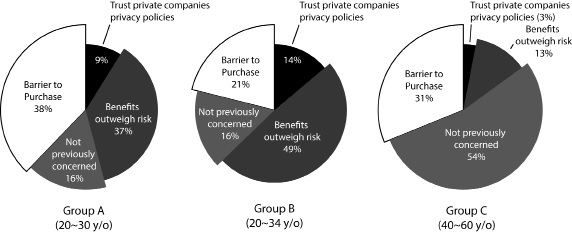
Q: Are you concerned about your personal data (finance, health, location, schedule, preferences…) being used or distributed without your consent?
When respondents were asked how important clients’ privacy is for most large reputable companies; A:9%-B:21%-C:0% believe this is one of their highest priorities, A:54%- B:41%-C:49% think that it is somewhat important, and A:37%- B:38%-C:51% assume that it is of low concern to services providers. In response, users believe that the data should be anonymized and encrypted before any transmission (A:62%-B:77%-C:83%); A:38%- B:21%-C:13% think it would only be necessary for sensitive information, and only 4% of older respondents (C) and 2% of the non-designers (B) believe encryption is superfluous.
3. 5. Ubiquitous Connectivity
Most IoT devices require constant connectivity to operate, some of them possibly not capable of providing basic functions when offline. This seems to be a concern to users, but A:49%- B:63%-C:33% respondents believe the advantages provided are outweighing the potential disagreement; A:26%-B:12%-C:29% had never thought about it; A:13%-B:12%-C:4% not concerned with the risk; and A:12%-B:13%-C:34% to whom this risk would deter them from purchasing a device that relies on a constant exchange of data. Asked about past experiences with connectivity problems resulting in their connected devices not functioning properly: A:24%-B:22%-C:42% rated their experience as a low inconvenience, and choose to rely on analog technologies to work, be informed or entertain themselves (listen to the radio, using pen and paper, read a book…); A:28%- B:31%-C:32% rating their experience as mildly incommoding; while A:48%- B:47%-C:26% found themselves truly incommoded, complaining that they were not able to achieve anything and found themselves deeply infuriated by the situation. (Figure 7)
3. 6. Energy consumption and environmental impact
Connected devices need energy to collect and transmit data, and although innovative technologies are currently being developed such as “power over Wi-Fi”, whereas sensors embedded in the environment capture ambient electromagnetic waves to power themselves, or kinetic energy harvesting; most currently available products and sensors still rely on traditional sources of energy.
In November 2015, the international community agreed on a plan to tackle the pressing issue of climate change. While some technologies such as the NEST intelligent thermostat are specifically designed to improve user comfort while optimizing energy consumption; one can be reasonably be concerned about the increased use of resources resulting from connecting growing number of objects that wouldn’t be specifically programmed for energy optimization or preservation. As of 2014, South Korea ranked last among the members of the OECD in the use of renewable energy. According to a report by the International Energy Agency, only 1.1 percent of its energy is generated from renewable sources (YonHap News, 2015). Still, issues of sustainable energy production and use is currently not a major concern of the Korean respondents: A:68%-B:40%-C:73% had not previously thought about it; A:21%- B:41%-C:14% did not think it was an important issue; and only A:11%- B:19%-C:13% actually hoped the technology would help better manage global energy consumption.
However, when asked if they were concerned about the increased energy usage and related cost of connected products: A:14%-B:2%-C:13% said it would prevent them from buying some devices; A:20%-B:26%-C:52% would specifically buy a device that is more energy efficient; A:33%-B:21%-C:13% believe connected devices do not use more energy than other products; A:17%-B:39%-C:9% think that the increase in cost is compensated by the services provided; A:10%-B:2%-C:4% hope that smart technologies would be more energy efficient than conventional products; A:7%-B:10%-C:9% did not care.
3. 7. Product reliability and pricing
The emergence of IoT consumer products offers the chance for companies to reinforce or establish long-term relationships with their clients. To Korean consumers, customer care is paramount and most reputable companies on the peninsula offer fast and reliable after-sale service and product maintenance.
Some concerns of the respondents regarding the reliability of IoT products are: A:28%- B:18%-C:43% believe that the complexity of the technology would make it more prone to failure and might prevent them from buying certain products; A:19%- B:10%-C:0% think that smart technology is making product more reliable; to A:19%- B:27%-C:17% the failure risk is outweighed by the benefits provided; A:30%-B:37%-C:31% do not believe it is a particular concern; only A:4%- B:8%-C:9% had not thought about it but may become an issue. (Figure 8)
As it often is the case, new and innovative products may bring innovation at a premium price, but only A:3%-B:7%-C:24% do not see price as a barrier to purchasing new products; A:38%-B:46%-C:14% may consider paying a substantial premium if the technology provides significant benefits while to the remaining A:59%- B:47%-C:62% high prices are a deterrent.
4. Discussion
As author and IoT strategist Scott Nelson said, “Consumers don’t buy IoT- they buy solutions to problems”, the majority of the respondents, including older subjects, seemed convinced that IoT technology has the potential to improve some aspect of their daily life, provided it worked reliably. However, considering the inherent complexity and interdependence of IoT systems, most respondents, including young design students, do not seem to fully grasp the extent to which this technology could impact their daily experiences.
Most respondents can easily envision how the technology could keep on improving aspects of their daily experiences in areas such as work, transportation and home automation; areas that have already been transformed by information technology or that are benefitting from mass-media exposure (AI, cleaning robots, self-driving cars). Nevertheless, interests in more personal areas such as health, personal finance or energy consumption that could be dramatically improved by an in-depth analysis of personalized data remains marginal; this may be due to a lack of compelling offer on the market at the moment but also because of the inability of consumers and young designers to envision the capabilities of IoT services; both of those issues should be explored further. As an example, when the respondents were asked whether they owned an activity tracker such as a Fitbit; while less than 3% of respondents owned such devices and among them the majority declared they had stopped using it within weeks of purchase or only using is as a watch.
Arguably one of the biggest disagreement that users may experience, besides inadequate battery autonomy, is that some IoT personal devices may require constant connectivity to operate, some of them possibly not capable of providing basic functions when offline, a problem that over a third of older respondents saw as a barrier to purchase, twice as much as the younger respondents. However, for many of the younger respondents, the experience of being offline was more often seen an inconvenience or even source of extreme annoyance. Robust data transfer infrastructures such as 5G technology are currently being built to remedy those problems; nonetheless, designers may wish to give their devices the ability to operate offline and offer basic functionalities, not only for entertainment or work but in particular in relation to the personal safety and health of users.
Similarly to other studies conducted in Europe and North-America, South-Korean respondents expressed concerns related to the vulnerabilities of connected services. Respondents have developed an enhanced awareness of the risk linked to connected devices in particular since more than half of them have had their personal devices infected by malware in the past. Worryingly, few of them believe that the companies providing IoT services are taking the necessary steps to protect their customers and many of them have mentioned that the revelation made by Edward Snowden, the data breaches experienced by large corporations or the mass-scale DDoS attack perpetrated from unsecured IoT devices that have been reported in the media recently have made them wary. At this stage, most respondents do not see those threats as barrier to purchase, in particular for products and services that offer them clear benefits, but they noticeably show a preference towards services with embedded security and privacy features such as the anonymization of data or encryption. It is also important to point out that the recent attacks on the banking industry or the hacking of data servers, allegedly perpetrated by foreign governments, have made cyber security not only an issue of personal but global safety.
According to research at Hewlett-Packard conducted in 2014, 70% of home IoT devices, such as TVs, fridges, toasters or garage doors, remain unsecured; in some case, due to a design error but often simply because users fail to set up devices properly or change the default password. Unsurprisingly most respondents, and in particular the overwhelming majority of the older group, expressed their displeasure setting up new devices, many of them finding the experience time consuming, frustrating or often confusing and preferred to have the installation process and personalization streamlined or in some case automated. It is therefore paramount that the user experience, from installation to the end of life, to be oriented not only towards convenience and personalization, but also to automatically integrate strategies prioritizing data security and privacy, such as automatic password randomization, end-to-end encryption, sandboxing and imbedded malware protection.
If our society chooses to move towards more sustainable modes of consumption and living, such as a more circular economy; the appropriate application of IoT technology may help to manage resources more efficiently with a particular focus on maintenance and repair.
Designers may want to take cues from the automotive industry which, although it can be criticized for still being the source of air pollutants and greenhouse gasses, has also over the past couple of decades increasingly embedded sensors in their vehicles making them more energy efficient and more reliable thanks to constant in-depth diagnostics.
This strategy is still largely inexistent in consumer products as many commercial enterprises today still rely on programmed obsolescence and the regular purchases of ever newer products by consumers; there may be temptation to leave the consumer largely ignorant and incapable to properly maintain products, anticipate a product failure or even understand its causes. While the opinions of the respondents did not show particular concerns for the environmental impact of IoT products, the older group did express concerns related to usage cost and lack of reliability of electronic devices. With the emergence of IoT pushing the transformation of business strategies from hardware to service provider, in conjunction with the urgent need of countries to reduce their pollutant emission, there may be a real incentive to design products that are more resource efficient and can be easily serviced, repaired or upgraded. Additionally, such approach if used to guarantee a seamless, friction-free and personalized customer care may reinforce brand loyalty and allow companies to establish longer-term sustainability goals.
Lastly, it is also important to note that when reviewing the aggregated results of the different age groups, one might deduct that, compared to younger respondents, the older group may seem more conservative. However, one should also refrain from making ageist assumption based on those results as it does not always reflect the individual views of the interviewees. When reviewed individually, the range of opinions becomes apparent and one can notice that some of the views of younger individuals were quite conservative while some of the older respondents expressed opinions that were at the opposite of the spectrum. Within the scope of developing products which have universal appeal, we should refrain to segregate users but rather identify issues that may be important to some and therefore, if addressed properly, benefit all users.
5. Conclusion
Information technology is increasingly becoming a core component of the industrial product development. This represents a dramatic shift for young design students and their educators as the projects they develop, rather than being isolated products, are increasingly becoming reliant interdependent ecosystem of things and are capable of increasingly complex behaviors.
While the prospects of IoT are extremely enticing, the questions designers and the industry should arguably focus on answering is not whether things can be connected, but if they should be and how to use connectivity to create true value to their customers by rethinking fundamentally the user experiences.
IoT technology offers designers the possibility to develop truly personalized, data-driven, user-centered products and services that can be optimized at every point of the product lifecycle, from retail to usage, maintenance, repair and the end of life.
As for any product, the relationship between cost and perceived value is an essential aspect of the purchase of IoT devices. However, for increasingly well-informed consumers, issues of privacy, usability, as well as reliability, maintenance, health impact, energy consumption have become important purchase criteria that may orient consumers towards competing products.
The result of this survey indicates that a large part of young designers does not intuitively choose to tackle those issues and therefore design educators may want to specifically develop strategies to address and integrate them to the development of connected products. Doing so and in order to compete in an increasingly crowded market, designers may take both technical advantages of the IoT technology as well as desires and concerns of the consumers into careful consideration in order to develop appealing, rewarding, convenient, safe and sustainable products and services.
Notes
Copyright : This is an Open Access article distributed under the terms of the Creative Commons Attribution Non-Commercial License (http://creativecommons.org/licenses/by-nc/3.0/), which permits unrestricted educational and non-commercial use, provided the original work is properly cited.
References
- Accenture. (2016). Digital Consumer Survey-Igniting Growth in Consumer Technology. Retrieved September 2, 2016, from https://www.accenture.com/_acnmedia/PDF-3/Accenture-Igniting-Growth-in-Consumer-Technology.pdf.
- Bullguard. (2016). Consumer guide to the internet of things. Retrieved June 2, 2016, from http://www.bullguard.com/community/resources/customer-guides/consumer-guide-to-the-internetof-things.aspx.
- Gartner. (2015). Gartner's 2015 hype cycle for emerging technologies. Retrieved June 2016, from https://www.gartner.com/newsroom/id/3114217.
- Groopman, J., & Etlinger, S. (2015, 07). Consumer Perception of privacy in the internet of things. Altimeter group. Retrieved June 8, 2016, from http://go.pardot.com/l/69102/2015-07-12/pxzlm.
- Hewlett-Packard. (2014, 07). Internet of Things Research Study. Retrieved June 3, 2016, from https://community.hpe.com/hpeb/attachments/hpeb/sws-22/1692/1HP_IoT_Research_Study.pdf.
- Morgan, J. (2014, 05). A Simple Explanation of The Internet Of Things. Forbes. Retrieved June 4, 2016, from http://www.forbes.com/sites/jacobmorgan/2014/05/13/simple-explanationinternet-things-that-anyone-can-understand/#5d1de00b6828.
- Nelson, S. (2016, 04). 3 ways IoT security concerns are taken out of context. CIO. Retrieved June 4, 2016, from http://www.cio.com/article/3053928/internet-of-things/3-ways-iotsecurity-concerns-are-taken-out-of-context.html.
-
Prensky, M. (2001). Digital natives, digital immigrants part 1. On the horizon, 9(5), 1-6.
[https://doi.org/10.1108/10748120110424816]

- Rose, D. (2014). Enchanted objects: Design, human desire, and the Internet of things. Simon and Schuster.
-
Whitmore, A., Agarwal, A., & Da Xu, L. (2015). The Internet of Things-A survey of topics and trends. Information Systems Frontiers, 17(2), 261-274.
[https://doi.org/10.1007/s10796-014-9489-2]

- Yon hap News Agency. (2015, 12). S. Korea's renewable energy use lowest in OECD: report. Retrieved December 7, 2016, from http://english.yonhapnews.co.kr/news/2015/12/02/0200000000AEN20151202002600320.html.
